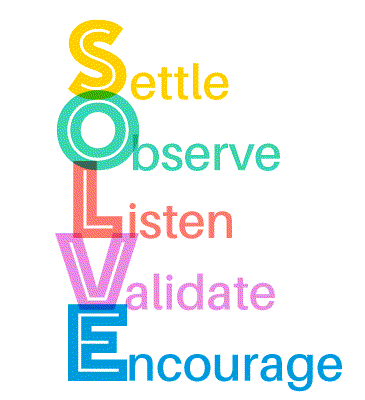Posted: June 21, 2023
The right mindset and helpful tools can help to recharge and support optimal problem-solving practices with young children. Author and educator Ann Gadzikowski shares, "our work as teachers and caregivers for children requires us to find light and joy in broken places" and that "the actual process of solving problems is where we find that light and joy" (Gadzikowski, 2022, p. 1). The wonderful thing about problem-solving is that it includes space to connect unlimited curiosity, meaningful learning, and continued hopefulness.

The SOLVE acronym: Settle, Observe, Listen, Validate, Encourage.
Children need our full attention to problem-solve. Although you may want to quickly fix problems as they arise, it is essential to support children and each other to linger in a space that encourages time to pause, listen, be curious, and reflect on our thinking and differing perspectives. Problem-solving requires time to investigate feelings, ideas, possibilities, and ways of interacting with each other.
Try the SOLVE model
Use effective problem-solving models, like the SOLVE model shared below, to generate multiple ways to solve problems. Effective problem-solving models incorporate consistent, intentional strategies that support children's ability to self-regulate, focus on tasks, think flexibly, and work with others.
Use the SOLVE model for self-reflection and to discuss with your early care and education (ECE) team. For example, use the SOLVE model to prompt conversations and to prepare for, observe, and follow up on problem-solving experiences in your ECE setting. You and your team can notice and document what SOLVE steps were used, how they worked, and what could be changed to improve your problem-solving approaches. And remember to celebrate the joy in the problem-solving process!
Explore the SOLVE model and handout below to add to your problem-solving tools!
- S--Settle, calm, and help children prepare for problem-solving
- O--Observe and acknowledge feelings and encourage feeling talk
- L--Listen to children identify the problem
- V--Validate and prompt the problem-solving process
- E--Encourage children with specific praise and feedback
SOLVE model: Steps to problem-solving (PDF)
Consider trying the new BKC course "Problem-Solving Approaches to Use Everyday!"
Reference
Gadzikowski, A. (2022). Problem Solving with Young Children: Building Creativity, Critical Thinking, and Resilience. Redleaf Press.

